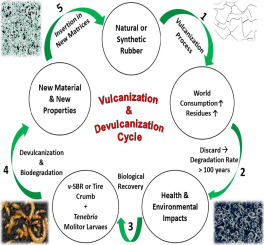Science of the Total Environment ( IF 9.8 ) Pub Date : 2018-08-21 , DOI: 10.1016/j.scitotenv.2018.08.228 Mostafa G. Aboelkheir , Leila Y. Visconte , Geiza E. Oliveira , Romildo D. Toledo Filho , Fernando G. Souza

|
The overall world consumption rate of rubber tends to increase by an average of 2.8% per year in the period between 2017 and 2025. Rubber residues represent a severe problem to both health and environment due to their cross-linked structure that offers a prolonged degradation rate. A good solution to eliminate this problem is recycling and recovery, aiming at the production of new materials. The tire crumb can be recycled by chemical/biological recovery, where the elastomer is devulcanized, or by physical recovery, where the three-dimensional network is transformed into small fragments. In this study, we investigated the bio-degradation effect caused by Mealworms (the larvae of Tenebrio molitor Linnaeus) on vulcanized SBR-rubber and tire crumb as a desulphurization method. The surface modifications of both rubbers were studied by instrumental techniques: FTIR-ATR, TGA, XRD, and SEM. The cross-linking degree of the rubber was determined via circular condensation method. The obtained results show that the Tenebrio molitor could survive after three weeks of direct contact with SBR-rubber and tire crumb as the only alimentation. There was a declining effect of cross-linking degree by increasing the contact time between the rubbers and larvae. The FTIR results indicate surface/chemical modifications of the rubbers and the SEM results show the free sulfur after it was released in the form of sulfur flower-like. Also, the TGA results highlight a difference in the degrading behavior and residues of the treated and non-treated rubbers. Therefore, the reported results were promising, demonstrating the biodegradation effect caused by the Tenebrio molitor mealworms, highlighting an alternative and natural mean of degrading vulcanized rubber residues.
中文翻译:

黄粉虫幼虫对硫化SBR和轮胎屑的生物降解作用。
在2017年至2025年期间,世界橡胶的总体消费率趋于以每年平均2.8%的速度增长。橡胶残留物的交联结构可延长降解速度,对健康和环境均构成严重问题。 。消除此问题的一个好方法是回收和回收,以生产新材料为目标。可以通过化学/生物回收(将弹性体脱硫)或物理回收(将三维网络转化为小碎片)进行物理回收来回收轮胎碎屑。在这项研究中,我们调查了由蠕虫(黄粉虫的幼虫)引起的生物降解作用。林奈(Linnaeus)使用硫化的SBR橡胶和轮胎屑作为脱硫方法。通过仪器技术研究了两种橡胶的表面改性:FTIR-ATR,TGA,XRD和SEM。橡胶的交联度通过圆缩合法测定。获得的结果表明黄粉虫与SBR橡胶和轮胎碎屑直接接触三周后可以存活下来,这是唯一的营养。通过增加橡胶与幼虫之间的接触时间,交联度降低的作用。FTIR结果表明橡胶的表面/化学改性,SEM结果表明游离硫以硫花状释放后。同样,TGA结果突出显示了处理过的和未处理过的橡胶在降解行为和残留物上的差异。因此,报道的结果令人鼓舞,证明了黄粉虫粉虫引起的生物降解作用,突显了降解硫化橡胶残留物的另一种自然途径。


























 京公网安备 11010802027423号
京公网安备 11010802027423号